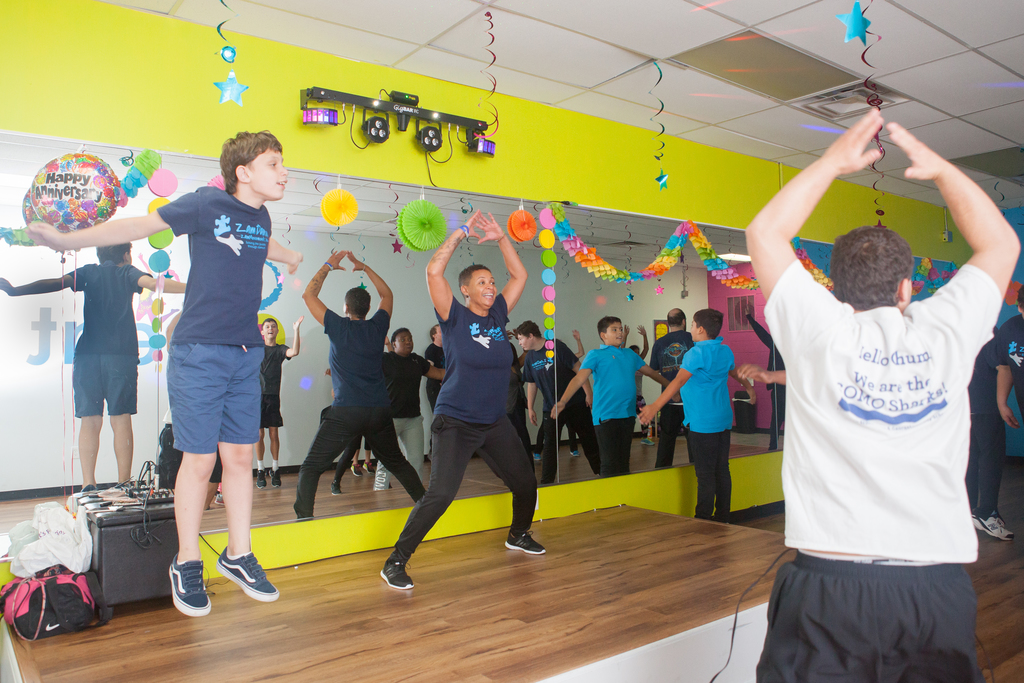
In a small studio in North Bethesda, 19-year-old Sam Alberts dances passionately on stage as he leads kids and adults through a challenging choreographed routine to Latin hit “Kulikitaka Ti.” He’s been performing the routine for years at ZamDance, a dance-fitness program dedicated to helping children and adults with intellectual and developmental differences find joy and expression through dance.
Alberts, who has autism and obsessive-compulsive disorder, uses athletics such as cross country and hockey to help regulate his body and emotions. When he joined ZamDance at 13, he found that the music and movement helped him set aside his underlying anxiety and frustrations. Now, he works as a volunteer assistant instructor and helps lead classes and events around the region.
“It keeps me fit and helps my mind move on from my anxious thoughts,” says Alberts. “Every time I do it, it puts me in a good mood.”
Since opening in 2013, ZamDance, a nonprofit organization, has become a hub of activity and acceptance for a range of disabilities, including autism, ADHD, Down syndrome and cerebral palsy. The high-impact hour-long sessions feature cardio exercises, such as jumping jacks and running in place, combined with dancing.
“When these kids walk into the studio, they can be themselves,” says Jackie Zamora, founder of ZamDance. “They’re not forced to move the way I move. There’s no judgment, just love.”
Zamora, a Brooklyn native, is a dancer and certified aerobics instructor. She trained in jazz and African dance in New York City, collaborated with French choreographer David Roussève at the Brooklyn Academy of Music and was the director of choreography for the off-Broadway show “RANG: Shades of my Soul,” in which she also danced.
When Zamora moved to Maryland in 2005, she found herself alone and broke in an unfamiliar area. Substitute teaching for special education classes, she discovered a passion for working with children with disabilities, which lead her to Ivymount School, where she became a one-to-one assistant teacher.
During her tenure at Ivymount, Zamora was invited to choreograph the school’s musical and was blown away by how well the students were able to learn and perform the dances. Realizing that she had never seen dance programs specifically designed for people with disabilities, Zamora considered creating one herself. She posed the idea to a friend, who suggested she call her program “ZamDance”
as a play on her name.
When she launched her first class that September, parents began spreading the word. And it got a big boost when Whitney Ellenby, author of “Autism Uncensored: Pulling Back the Curtain,” got wind of the class: Ellenby befriended Zamora and started promoting ZamDance to a number of disability programs in which she was involved.
“Whitney was a huge reason this program blew up,” Zamora says. “I just wanted to teach a class once a week, but it became something bigger than myself.”
Zamora refers to ZamDance as a “movement” because of the way it’s changed the lives of students and their parents. Leslie Zelaya, a 20-year-old with cerebral palsy, was in a wheelchair when she first joined ZamDance in 2015. Now, Zelaya has built up enough muscles in her legs that she can use a walker and teach classes.
“She saw the other kids dancing and decided that she wanted to be on a walker,” says Zamora. “That’s another beautiful part about this program — kids aren’t being pushed, they genuinely want to come and dance.”
The program also helps assistant instructors like Alberts build confidence while providing them the opportunity to help others.
“I wanted to be a leader because I like music and I love mentoring people,”
says Alberts.
Alberts, who attends Kennedy Krieger School, is using his experience to create a dance fitness class at his school called “Have a Little Faith in Me,” named after the John Hiatt hit, Alberts’ favorite song.
“It’s been a real opportunity for Sam to travel around, meet new people and just feel what it’s like to be leading something,” says his mother, Tracey Wright. “For me, it’s been super enjoyable to just be out there meeting other families. I see these amazing people with different abilities and they’re able to express themselves in their own way.”
When COVID-19 hit, the parents of ZamDance participants immediately helped Zamora set up Zoom classes. Their backing went a long way toward alleviating her concerns over whether she could pull it off.
“We do virtual events and these kids show up consistently. It’s essential for them,” says Zamora.
With all of the opportunities for social connections, structure and routine gone, ZamDance became a lifeline for Alberts during the pandemic.
“Sam needs a lot of motor movement, so ZamDance was crucial for us during those first eight months,” says Wright. “It was so great because he could also see other people and maintain those social connections.”
Now, as the world begins to open up, Zamora is excited to travel again, train more students to become teachers and open up a ZamDance nightclub. While she would like to expand to different areas, she says it’s difficult to do so with this kind of program. But no matter what the future brings, Zamora is satisfied that she’s making a difference.
“When you see kids with disabilities having the confidence to get up on stage and learn and teach a routine,” says Zamora, “you have to admit that you’re solving a puzzle.”




